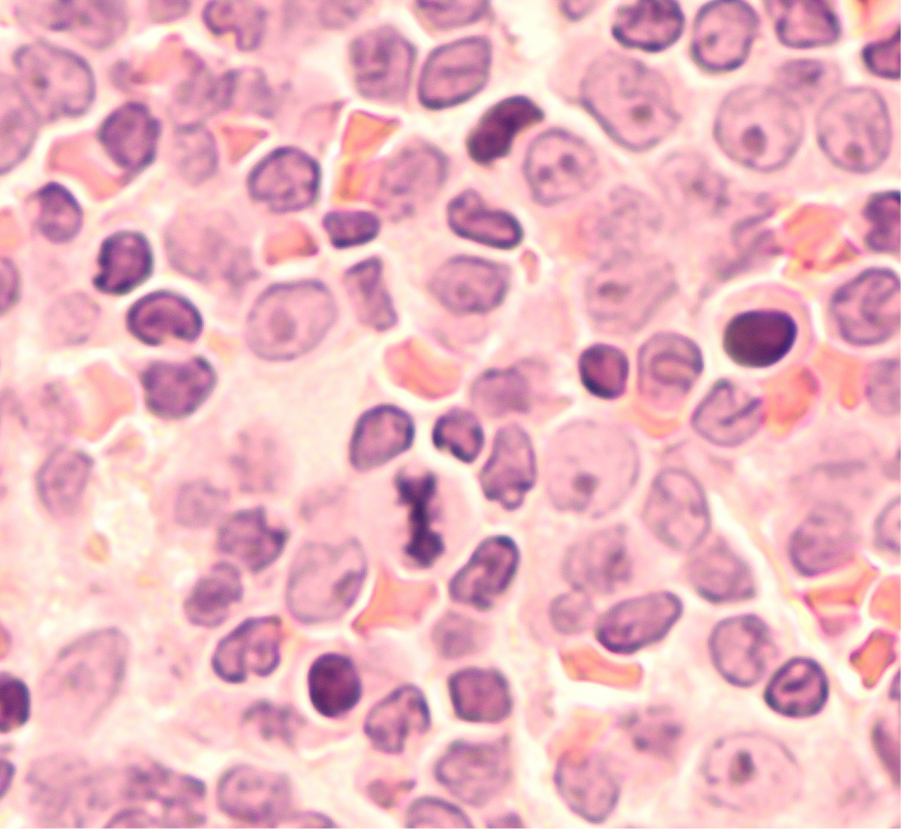


Diffuse Large B-Cell Lymphoma (DLBCL) is a type of non-Hodgkin lymphoma that affects the cells and organs of the immune system. There are different types of DLBCL, including high-grade B-cell lymphoma and DLBCL that arise from follicular lymphoma.3
B cells, T cells and glands called lymph nodes make up the body’s immune system which protects the body from diseases.3 Sometimes, the cells
inside a lymph node can grow abnormally and become cancerous. Patients with Diffuse Large B-Cell Lymphoma (DLBCL) have abnormal (cancerous) B cells in their lymph nodes, and potentially in other parts of the body.
Symptoms of DLBCL include rapid swelling in the neck, underarms, or groin that is caused by enlarged lymph nodes.4

Learn more about CAR-T cell therapy, an innovative form of immunotherapy for ALL and DLBCL patients whose current treatment may not be responding, or whose cancer has relapsed.
CAR-T Therapy involves altering one’s personal T cells, a type of white blood cell found in the immune system, with new chimeric antigen receptors (or CAR for short). When the CAR is combined with your T cells, the CAR-T cell therapy enhances the body’s natural ability to treat cancer with reprogrammed T cells. Thus, having the potential to cure the cancer completely with a one-time CAR-T treatment. Click on the video to learn more.
since the first FDA approved therapy was made available in 2017.1213
CAR-T cell therapy is an individualized treatment made from the body’s own T cells. However, data shows that T cell health will decline over time and result in poorer outcomes especially when additional treatments such as chemotherapy have been performed.
Potentially curative for patients
who are not responding well to initial treatments
Harnesses the power of your own
T-cells to detect and treat
cancerous B cells
A one-time infusion treatment
either with or without
hospitalization

CAR-T cell therapy is a one-time, potentially curative, and innovative treatment option. CAR-T cell therapy is approved worldwide (by the FDA since 2017 and over 30 other health authorities) for patients who have certain types of leukemia and lymphoma, including Pediatric Acute Lymphoblastic Leukemia (pALL) and Diffuse Large B-cell Lymphoma (DLBCL).
While the goal of CAR-T cell therapy is long-term recovery of cancer, it is important to note that not all patients will respond the same way.
Studies have shown that among patients diagnosed with DLBCL:17

SA, K. A. (Ed.). (2021). Diffuse Large B Cell Lymphoma. StatPearls Publishing. Available from: https://www.ncbi.nlm.nih.gov/books/NBK557796/
Susanibar-Adaniya, S., & Barta, S. K. (2021). 2021 Update on Diffuse large B cell lymphoma: A review of current data and potential applications on risk
stratification and management. American Journal of Hematology, 96(5), 617–629. https://doi.org/10.1002/ajh.26151
Lymphoma action. (n.d.). Lymphoma Action. Retrieved March 11, 2022, from https://lymphoma-action.org.uk/types-lymphoma-non-hodgkin-lymphoma/ diffuse-large-b-cell-lymphoma
Patient education: Diffuse large B cell lymphoma in adults (Beyond the Basics). (N.d.). Uptodate.Com. Retrieved March 11, 2022,1/12/LRF-Non-Hodgkin- Lymphoma_Factsheet.pdf.
Treating B-cell non-Hodgkin lymphoma. (n.d.). Cancer.Org. Retrieved March 11, 2022, from https://www.cancer.org/cancer/non-hodgkin-lymphoma/ treating/b-cell-lymphoma.html
Chemotherapy for acute Lymphocytic leukemia (ALL). (n.d.). Cancer.Org. Retrieved March 11, 2022, from https://www.cancer.org/cancer/acute- lymphocytic-leukemia/treating/chemotherapy.html
Targeted therapy for acute Lymphocytic leukemia (ALL). (n.d.). Cancer.Org. Retrieved March 11, 2022, from https://www.cancer.org/cancer/acute- lymphocytic-leukemia/treating/targeted-therapy.html
Immunotherapy for acute Lymphocytic leukemia (ALL). (n.d.). Cancer.Org. Retrieved March 18, 2022, from https://www.cancer.org/cancer/acute- lymphocytic-leukemia/treating/monoclonal-antibodies.html
CAR-T cell therapy: Pioneering cancer therapy. (n.d.). Novartis. Retrieved March 11, 2022, from https://www.novartis.com/research-development/ technology-platforms/cell-therapy/car-t-cell-therapy-and-beyond/car-t-cell-therapy-pioneering-cancer-therapy
Radiationtherapyforchildhoodleukemia.(n.d.).Cancer.Org.RetrievedMarch11,2022,fromhttps://www.cancer.org/cancer/leukemia-in-children/ treating/radiation.html
How stem cell and bone marrow transplants are used to treat cancer. (n.d.). Cancer.Org. Retrieved March 11, 2022, from https://www.cancer.org/ treatment/treatments-and-side-effects/treatment-types/stem-cell-transplant/why-stem-cell-transplants-are-used.html
Pharma,K.(2021).YescartaPatintBrochure.–extractedfromNovartisresource
Novartis. (n.d.). Kymriah Patient Numbers – extracted from Novartis resource
Zhang, H., Weyand, C. M., & Goronzy, J. J. (2021). Hallmarks of the aging T‐cell system. The FEBS Journal, 288(24), 7123–7142. https://doi.org/10.1111/ febs.15770
Novartis. (2021). Kymriah Real-World Evidence Summary. – extracted from Novartis resource
Kymriah® (tisagenlecleucel), first-in-class CAR-T therapy from Novartis, receives second FDA approval to treat appropriate r/r patients with large B-cell lymphoma. (n.d.). Novartis. Retrieved March 11, 2022, from https://www.novartis.com/news/media-releases/kymriah-tisagenlecleucel-first-class-car- t-therapy-from-novartis-receives-second-fda-approval-treat-appropriate-rr-patients-large-b-cell-lymphoma
MorphoSys. (2021). Diffuse Large B-cell Lymphoma (DLBCL). Dlbclsupportsource.Com. https://www.dlbclsupportsource.com/pdf/diffuse-large-b-cell- lymphoma-guide.pdf
Disclaimer:This is global website for information on CAR-T Cell Therapy and is intended for Patients and Caregivers outside the US. The information on the site is not country specific and may contain information that is outside the approved indication in the country in which you are located.